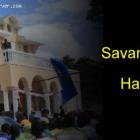ADVERTISEMENT
poverty - Haiti Observer Blog
poverty, Haiti Observer Blog. Read the following articles about poverty
What is Ti Manman Chery and Ede Pep?
Ti Manman Cheri is a social welfare program that was launched on 27th May 2012 by the President of the Republic of Haiti. It is the first of its kind welfare program under which, the government will provide facilities to extremely poor families with children. The program will facilitate schooling and improve living conditions and the first beneficiaries targeted were Carrefour Feuilles, Cité Soleil, Fort National and Bel-Air. The government planned to use $13 million from PetroCaribe to fund this program.
According to Ti Manman Cheri, government proposed to send money through Tchocho mobile phone service of Digicel to every mother given the condition that their children enrolled and went to school regularly. 400, 600 or 800 gourdes would be given every month to mothers with 1, 2 or 3 child respectively. Initial registration was decided to be for 6 months with 10 allowed renewals totaling up to 5 years. The program aimed at reaching 100,000 beneficiary families.
Jalousie Slum Makeover, Beauty Versus Poverty in Color
A psychedelic makeover of Jalousie slum in Haiti is under progress. This uninviting concrete block of homes lay on mountainside of the capital of Haiti. The makeover of this largest shantytown of Haiti covers two aspects - homage and art. The facades are being painted by workers in cream, lime, peach and purple. The inspiration for these colors comes from Prefete Duffaut's work "Cities-in-the-skies". Duffaut was a great Haitian painter who died in 2012.
The whole effort is given a name - 'Beauty versus Poverty: Jalousie in Colors'. The project will cost $1.4 million and this slum makeover is an attempt of government to relocate the people living in displacement camps that were a result of 2010 earthquake. The government plans to pick up some high-profile camps in the nation's capital and relocate them in places like Jalousie while paying rent for a whole year in form of subsidies for those residents. The government also plans in tidying up these areas by providing city services and aims towards building up a place that will be decent for living and people will be proud to be a part of the place.
Haiti, one of 8 countries in the world half of its children not attending school
Of 8 nations in world where half of the children don't attend school, Haiti is one of the countries. It is because of this reason that Laurent Lamothe - Prime Minister of Haiti and Vanneur Pierre - Minister of Education for Haiti attended a meeting with UNESCO in Washington D.C. along with the ministers of the 7 other nations. The other nations include South Sudan, Yemen, Nigeria, India, Ethiopia, the Democratic Republic of Congo and Bangladesh.
UNESCO called this meeting to discuss the challenges faced by these countries and the steps that can be taken to open doors for education for the children. International Monetary Fund and World Bank hosted a ministerial meeting on April 18 with a theme called 'Learning for All'. Michaëlle Jean, UNESCO Special Envoy for Haiti also attended the meeting. It was informed to the press by Michaëlle Jean that she participated in the round table that dedicated specifically for Haiti alongside Vanneur Pierre, Laurent Lamothe, Irina Bokova (Director General of UNESCO) and Gordon Brown (US Special Envoy for Global Education).
New Pope Francis, Cardinal Jorge Mario Bergoglio Of Buenos Aires
The Catholic cardinals picked a new pope among themselves on Wednesday, March 13, 2013. He is Cardinal Jorge Mario Bergoglio. The new pope,Jorge Mario Bergoglio, 76, will be called Francis, the 266th pontiff of the Roman Catholic Church.
New Pope Jorge Mario Bergoglio' s First Pray 13.03.2013
White Smoke Rises Over Vatican, the Catholic Church has made history. The New Pope is the first non-European leader of the church in more than 1,000 years.
Who is Cardinal Jorge Mario Bergoglio?
Haiti And Dominican Republic, Geographical And Historical Differences
While Haiti suffers, Dominican Republic is well off and occupies Caribbean Island of Hispaniola up to around 30,000 sq m. It is filled with resorts, is prosperous and healthy while Haiti continues to be poverty stricken. The Dominican Republic is ranked 90th on the human development index out of the 182 countries while Haiti comes 149th.
In Haiti the life expectancy is 61 years while in the Dominican Republic it is 74 years. In case a person lives on 2/3rds of eastern Hispaniola then he is more likely to write and read and live on less than 1.25 dollars a day.
Poverty And Crime In Cite Soleil
Comfortable living space, safety, security and luxury are some of the things that are uncommon among people living in Cite Soleil, an extremely poor town in the Arrondissement of Port-au-Prince in Ouest Department. As a matter of fact, it is considered one of the poorest and most dangerous towns in Haiti.
Around 400,000 residents live in Cite Soleil without a decent access to electricity. The sewerage and canal systems in the town are in poor condition, while only a few businesses are open to serve the residents. There are some hospitals and only one school. While half of the houses in Cite Soleil were made of cement and metal roof, the other 50% were makeshift shelters built in materials that residents have scavenged.
Mombin-Crochu and Living condition
Many people in the town of Mombin-Crochu in the Vallieres Arrondissement live in poverty. Residents do not have the luxury of living a very comfortable life, as Mombin-Crochu is one of the poor towns in the country. In fact, children are forced to walk barefoot because they do not have money to buy slippers. They also walk just to go to school because only a few have access to donkeys, which are the main transportation in the town.
When it comes to utilities, residents in Mombin-Crochu have to go by without a regular supply of water and electricity because they could not afford it. In order to make fuel and cook, they use charcoal and wood fire.
Prime Minister Laurent Lamothe Initiates Ede Pep Program in La Plaine du Nord
To meet the overwhelming need of the hunger that exists in much of Haiti, the government of Haiti (GOH) initiated a new government program, Ede Pep (Help People). Haiti Prime Minister, Laurent Lamothe, traveled to La Plaine du Nord to hand out 2,500 baskets of food to residents.
Lamothe spoke at length about the goals of Ede Pep, which will benefit 50,000 people monthly. Its plan is to purchase from local farmers, which will help them improve their living conditions. The food bank will give out these food donations where the need is greatest.
Lamothe acknowledged the many problems the residents of La Plaine du Nord experience, and by extension "in all departments in all cities of the country." In particular, he addressed the damaged road conditions and theft of livestock that have plagued the city since the 2010 earthquake.
Deportation to Haiti disastrous for the country
For the many scores of Haitians living in the United States, the Dominican Republic and other countries within the realm of the United Nations, deportation back to a country still devastated after the 2010 earthquake is an imminent threat. Many living in the U.S. before the earthquake, set for deportation after serving prison sentences or being caught by immigration, were given a reprieve that has since been recalled in light of the current stance of the U.S. on issues of immigration. However, this spate of deportation to the still-crippled nation has many human rights experts crying shame on participating countries and asking for their reconsideration.
The State Of Prostitution In Haiti
With the weak economy and poor living conditions in Haiti, many women, including teenagers, have settled to becoming prostitutes just to earn. Prostitution is illegal in the country but this does not stop women from getting paid for sex. Since the 1940s, prostitution rings have been active in the country and it only got worse as time went by and catastrophes hit the Caribbean nation.
According to a report in 2005, Haitian children were being trafficked in the Dominican Republic, where they were forced to work as slaves or prostitutes. Many of these children were orphaned, while others can no longer be supported and fed by their parents. As a result, they are brought to the Dominican Republic and sold to families and individuals looking for a child laborer. There were reports that the trafficked children have been physically abused too and some were so traumatized they can not recall how they got to that situation.
Our objective is to share with you news and information about Haiti and the people of Haiti. Traditions, habits and the way we were or grew are alive in this site. We highly recommend that you Subscribe to our Newsletter and also share with us some of the things that are memorable and made us unique people.

 Life After Death
Life After Death  Newsletter
Newsletter  Battle of Vertieres
Battle of Vertieres  The Town of Savanette, Haiti
The Town of Savanette, Haiti  Something to think about
Something to think about